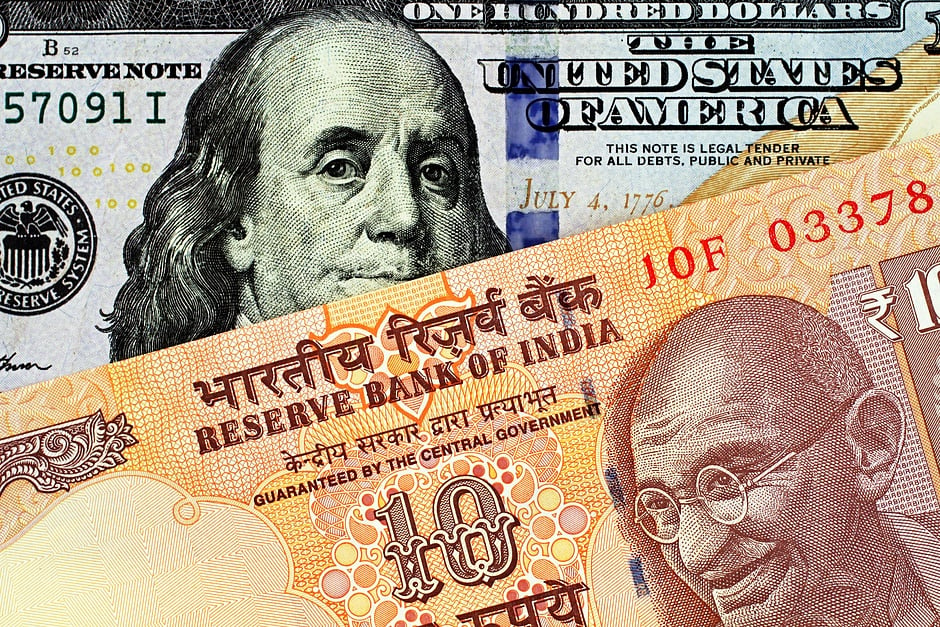USD/INR holds gains near 83.50, traders expect the potential for intervention
- USD/INR could test an all-time high of 83.7190 level.
- The Indian Rupee could limit its downside as traders expect potential for intervention by the RBI.
- The US Dollar continues to gain ground due to increased risk aversion.

USD/INR continues to appreciate, trading around 83.60 during the early European session on Friday. The Indian Rupee (INR) has avoided testing an all-time low at 83.7190 against the US Dollar (USD), likely due to anticipated intervention by the Reserve Bank of India (RBI), according to market participants.
The upside of the USD/INR pair can be attributed to the strengthening of the US Dollar amid increased risk aversion. The Greenback is also bolstered as US Treasury yields continue to improve. However, the USD's upside potential may be constrained by soft labor data, which enhances market expectations for a Federal Reserve (Fed) rate cut in September.
US Initial Jobless Claims increased more than expected, data showed on Thursday, adding 243K new unemployment benefits seekers for the week ended July 12 compared to the expected 230K, and rising above the previous week’s revised 223K.
On the INR front, traders are likely awaiting the release of India's FX Reserves (USD) data for the week ending July 8, scheduled for Friday. Additionally, attention is focused on the Union Budget 2024-25, which will be presented to parliament next week.
Earlier this week, the International Monetary Fund (IMF) revised its economic forecast for India, now projecting a growth rate of 7% for this year, up from the 6.8% forecast in April. This adjustment is attributed to stronger consumer spending in rural areas.
Indian Rupee FAQs
The Indian Rupee (INR) is one of the most sensitive currencies to external factors. The price of Crude Oil (the country is highly dependent on imported Oil), the value of the US Dollar – most trade is conducted in USD – and the level of foreign investment, are all influential. Direct intervention by the Reserve Bank of India (RBI) in FX markets to keep the exchange rate stable, as well as the level of interest rates set by the RBI, are further major influencing factors on the Rupee.
The Reserve Bank of India (RBI) actively intervenes in forex markets to maintain a stable exchange rate, to help facilitate trade. In addition, the RBI tries to maintain the inflation rate at its 4% target by adjusting interest rates. Higher interest rates usually strengthen the Rupee. This is due to the role of the ‘carry trade’ in which investors borrow in countries with lower interest rates so as to place their money in countries’ offering relatively higher interest rates and profit from the difference.
Macroeconomic factors that influence the value of the Rupee include inflation, interest rates, the economic growth rate (GDP), the balance of trade, and inflows from foreign investment. A higher growth rate can lead to more overseas investment, pushing up demand for the Rupee. A less negative balance of trade will eventually lead to a stronger Rupee. Higher interest rates, especially real rates (interest rates less inflation) are also positive for the Rupee. A risk-on environment can lead to greater inflows of Foreign Direct and Indirect Investment (FDI and FII), which also benefit the Rupee.
Higher inflation, particularly, if it is comparatively higher than India’s peers, is generally negative for the currency as it reflects devaluation through oversupply. Inflation also increases the cost of exports, leading to more Rupees being sold to purchase foreign imports, which is Rupee-negative. At the same time, higher inflation usually leads to the Reserve Bank of India (RBI) raising interest rates and this can be positive for the Rupee, due to increased demand from international investors. The opposite effect is true of lower inflation.
Author

Akhtar Faruqui
FXStreet
Akhtar Faruqui is a Forex Analyst based in New Delhi, India. With a keen eye for market trends and a passion for dissecting complex financial dynamics, he is dedicated to delivering accurate and insightful Forex news and analysis.

















